Archive:Korea-EU - business demography
- Data from September 2013. Most recent data: Further Eurostat information, Main tables and Database.
This article presents statistics for Korea and for some of the largest member states of the European Union (EU) on the number of active enterprises, the creation of new enterprises, the survival of such new enterprises and the closure (‘deaths’) of enterprises. This is generally called business demography statistics. The economic sectors covered are the business economy, more specifically industry, construction and services. In technical terms, this corresponds to sections B to N of NACE Rev.2 and the Korean activity classification KSIC, excluding activities of holding companies (K64.2).
In 2010, the EU economy was made up of around 24 million active enterprises (based on data from 26 member states). The largest active enterprise population in the EU was registered in Italy with 4.0 million, followed by Spain, France, Germany and the United Kingdom. In Korea, the population of active enterprises was 5.1 million in 2010. In the EU as a whole and in the five largest European economies, the service sector made up around three quarters of the active enterprises. In Korea, the service sector was even more dominant, making up 86 % of the total population of active enterprises.
In the European economies, the birth and death rates of enterprises tend to be around 10 % of the number of active enterprises. In Korea, these birth and death rates tend to be around 15 %. In 2010, there were more enterprise births than deaths in Korea, Germany and France, while there were more deaths than births in Italy, Spain and the United Kingdom. For the EU as a whole, the one-year survival rate for enterprises created in 2009 was 81 %; the five-year survival rate of enterprises born in 2005 and still active in 2010 was 46 %. Amongst the five major European economies, the one-year survival rate was highest in the United Kingdom and Italy, while the five-year survival rate was highest in France and Italy. In comparison, these survival rates were significantly lower in Korea.

(* EU-28: Data for Greece and Croatia not available)
Source: Eurostat (bd_9b_sz_cl_r2)
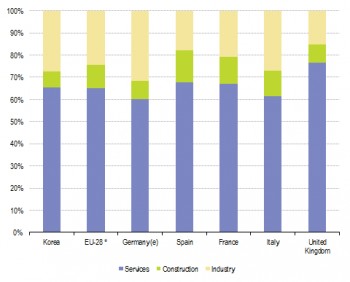
(* EU-28: Data for Greece and Croatia not available)
Source: Eurostat (bd_9b_sz_cl_r2)
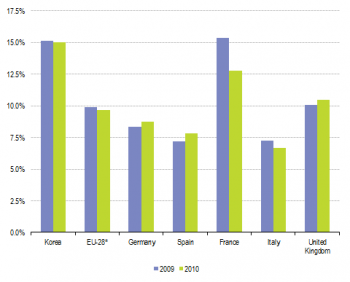
(* EU-28: Data for Greece and Croatia not available)
Source: Eurostat (bd_9b_sz_cl_r2)
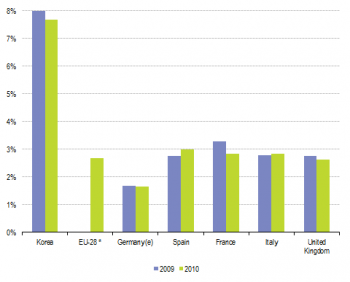
(* EU-28: Data for Greece and Croatia not available)
Source: Eurostat (bd_9b_sz_cl_r2)
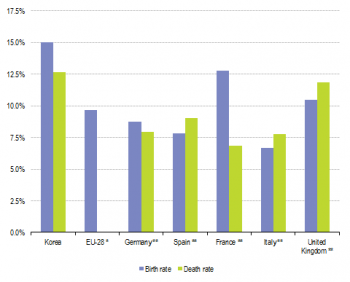
(* EU-28: Data for Greece and Croatia not available)
(** Germany, Spain, France, Italy and United Kingdom: Death rate provisional)
Source: Eurostat (bd_9b_sz_cl_r2)

(* EU-28: Data for Greece and Croatia not available)
(** Germany, Spain, France, Italy and United Kingdom: Death rate provisional)
Source: Eurostat (bd_9b_sz_cl_r2)
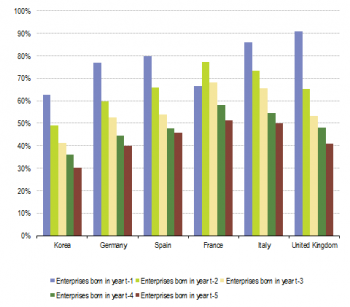
(* EU-28 not available)
Source: Eurostat (bd_9b_sz_cl_r2)

(* Germany, Spain, France, Italy and United Kingdom: Death rate provisional)
(** EU-28 not available)
Source: Eurostat (bd_9b_sz_cl_r2)
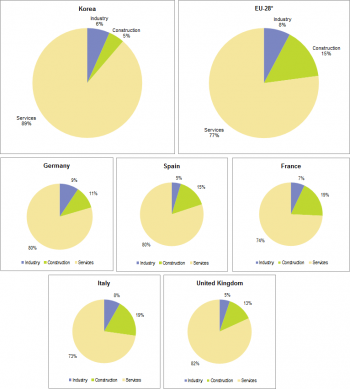
(* EU-28: Data for Greece and Croatia not available)
Source: Eurostat (bd_9b_sz_cl_r2)
Main statistical findings
The number of active enterprises in Korea continued to grow in 2010
The business enterprise population consists of active enterprises in the industry sector (Sections B to E of NACE Rev.2 and KSIC), the construction sector (Section F) and the service sector (Sections G to N, excluding activities of holding companies – K64.2). The aggregated data for the EU aggregate were based on the 26 member states for which 2010 data were available (data are not yet available for Greece and Croatia).
In 2010, the total number of active enterprises in the business economy in the 26 EU member states for which data are available was 24.1 million, an increase of 0.3 % on the previous years. In the Republic of Korea, the total number of active enterprises was 5.1 million in 2010, up 2.2 % from 2009; in 2011, the population of active enterprise reached 5.3 million. In comparison, in 2010 the population of active enterprises in the main economies of the EU were 4.0 million in Italy, 3.1 million in Spain, 3.0 million in Germany, 2.9 million in France and 2.0 million in the United Kingdom. From 2009 to 2010, the number of active enterprises increased in France (+1.6 %) and Germany (+0.7 %), remained relatively stable in Italy (-0.3 %) and decreased in Spain (-3.0 %) and the United Kingdom (-4.8 %).
At EU level as in Korea and in the five key economies mentioned, the service sector made up the main share by far of the enterprise population in 2010. The dominance was strongest in Korea (86 %), while the service sector in the EU as a whole and in Germany, Spain, France, Italy and the United Kingdom made up around three quarters (between 73 % and 77 %) of all active enterprises. The construction sector made up between 13 % and 18 % in these European economies, and the industry sector between 8 % and 11 %. In comparison, the industry sector in Korea (8 % of the active enterprises) was as the same level as in these European economies, while the construction sector only made up 6 % of the active enterprises.
Industry remained important to employment in Germany and Italy
Although the enterprises in the industry sector only make up a tenth of the enterprise population in the EU, they employed slightly more than a quarter of the employees in the business economy in 2010. In contrast, the service sector made up three quarters of the number of active enterprises, but only employed somewhat less than two thirds of the employees in the business economy. In real numbers, there were 72 million employees in services and 31 million employees in industry in the 26 member states for which 2010 data are available. This means that the enterprises in the industry sector in the EU had 13 employees on average, while the enterprises in the service sector had 4 employees on average.
In comparison, the industry sector in the Republic of Korea employed 4.3 million employees in 2010, making up 27 % of all employees in the business sector. The enterprises in the service sector had 10.3 million employees, corresponding to 65 % of the total. This was a similar balance as for the EU as a whole. Amongst the main European economies, the industry sector was most important in Germany and Italy, with 35 % and 34 % of the employees in the business economy respectively; employment in the service sector was correspondingly 58 % in Germany and 56 % in Italy. In the United Kingdom, employment in the service sector was much larger, accounting for 77 % of the employees in the business economy, while the industry sector only comprised 16 %.
These numbers imply that the average number of employees in enterprises in the industry sector was 10 in the Republic of Korea in 2010, compared to 22 in Germany and 18 in the United Kingdom. This contrasted with the average of 8 employees in the industry enterprises in Italy and 9 employees in Spain. For the services sector, the average number of employees was 2 in Korea in 2010, close to the level in the EU-28 (4 employees on average), while the United Kingdom stood out with an average of 9 employees in the service sector enterprises. For the construction sector, the average number of employees was between 2 and 4 for the EU as a whole, for Korea and for the five key European economies studied.
High enterprise birth rates in Korea and France
The birth of new enterprises is often seen as an indication of the dynamism of an economy, as newly founded enterprises are considered drivers of job creation and economic growth. Through the application of the newest technologies and methods and responding to the latest market needs, new enterprises are generally considered to increase competition in the economy and thus stimulate innovation, improved productivity and the overall competitiveness of a country's enterprises.
Generally, the birth rates of enterprises tend to be around 10 % of the total number of active enterprises. However, in Korea the birth rates lay around 15 %. The birth rates in France almost approach those in Korea, while the birth rates in the United Kingdom lay at around 10 % and in the other main European economies between 6 % and 9 %. In the EU, the share of newly born enterprises declined slightly from 2009 to 2010. It should be noted that the high birth and death rates recorded in Korea may partly be explained by methodological differences – see the methodological notes below for more details.
From 2009 to 2010, the enterprise birth rate in France fell by 2.7 percentage points, from 15.6 % to 12.9 %, which was still a high level compared to the other key European economies. In the Republic of Korea, the birth rate remained stable at around 15 %. For the other main European economies there were only minor changes in the enterprise birth rate, ranging from a slight decline of 0.6 percentage points to 6.6 % in Italy to an increase of 0.7 percentage points to 8.0 % in Spain.
Looking at the enterprise births by sector, the new enterprises in the service sector made up a slightly higher share than in the overall population of active business economy enterprises in Korea, Germany, Spain and the United Kingdom. In Korea, the service sector made up 89 % of enterprise births in 2010; in the other three economies this share was around 80 %.
In the total business economy in 2010, the share of newly born enterprises in the total employment of active enterprises lay at 7.7 % in Korea. This was considerably higher than in the five major European economies; in Germany the share was 1.6 %, while it ranged from 2.5 % to 3.2 % in Spain, France, Italy and the United Kingdom. There were only minor changes in these shares from 2009 to 2010. However, it is worth noting that for France the share of employment in enterprise births within the total business economy employment only declined by 0.5 percentage points, despite the fall of 2.7 percentage points in the enterprise birth rate.
With the exception of Italy, enterprise death rates fell from 2009 to 2010
Deaths of enterprises are generally caused by an enterprise’s lack of economic success. This may be caused by inefficient or outdated production processes, products that are not attractive in the market, prices that are not covering costs, or a range of other issues. The closure may be voluntary or may be caused by bankruptcy or similar. Thus, enterprise deaths tend to reflect the dynamics of the economy and changes in markets. As seen in recent years, liquidity problems and problems in finding financing in times of economic crisis may also be critical factors.
The death rates of enterprises are similar to the birth rate levels, at around 10 % on average; in Korea the death rate was almost 13 % of the active enterprises in 2010. In the United Kingdom the death rate was 11 % in 2010, while the death rates in the other main European economies were between 6 % and 9 %. With the exception of Italy, where a marginal increase of 0.1 percentage points was registered, the enterprise death rates fell from 2009 to 2010 for the economies analysed. It should be noted that the higher level of the death rates recorded in Korea may be partly explained by methodological differences – see the methodological notes below for more details.
Amongst the countries studied in this article, in 2010 the enterprise death rate was higher than the birth rate for Spain, Italy and the United Kingdom. In Italy, this negative difference increased from 2009 to 2010. In contrast, for Germany the balance turned from negative in 2009 to positive in 2010; in other words, the business enterprise population started to grow again in 2010 after a fall in 2009. Korea and France recorded higher birth than death rates in both 2009 and 2010, with a continuously growing enterprise population. In 2010, the difference between the birth and death rates continued to grow in Korea, meaning that the growth in the enterprise population accelerated further; in France the birth-rate shrank, slowing down the growth in the enterprise population.
Enterprise deaths lead to the loss of jobs. In 2010, 5.8 % of the jobs in the business economy in Korea were lost due to enterprise deaths. The job loss was heaviest in the service sector, where 7.2 % of the jobs were lost due to enterprise deaths. The corresponding share in the construction sector was 4.5 % and in industry 2.7 %. In the major European economies, the job loss due to enterprise deaths was strongest in the construction sector; hardest hit was the United Kingdom, where 6.4 % of construction jobs were lost. Germany was a special case; in 2010 the shares of jobs lost due to enterprise deaths were merely between 0.1 % and 0.3 % in the three sectors. This may reflect that the majority of jobs had been lost already before the year when the activities of the enterprise effectively stopped, or it may reflect that the deaths predominantly affected smaller enterprises.
High short term survival rate in the United Kingdom and Italy
A critical element of the potential of newly born enterprises to stimulate economic growth and employment is their ability to survive. Thus, business demography statistics focus on the survival rate of newly born enterprises up to five years after their creation, tracing how many have survived. Data are presented for the one- to five-year survival rates.
The available data show relatively low one- to five-year survival rates for Korea. However, this may to a certain extent be influenced by methodological issues, as Korea records the death of an enterprise when there has been one calendar year without activity; the OECD-Eurostat methodology, on the other hand, records the death of an enterprise after two years without activity.
The one-year survival rate for enterprises shows that very high shares of newly born enterprises survive in the United Kingdom and Italy; in the United Kingdom, 91 % of the enterprises survive their first year, in Italy 86 %. In contrast, only 67 % and 63 % of enterprises in France and Korea respectively survived their first year from 2009 to 2010.
The survival rates fall gradually over the five year studied, but the decrease in the year-on-year survival rates slows down over the period. The decrease in survival rates is sharpest from one-year survival to two-year survival. The data indicate that if enterprises survive the first years after their birth, they have a better chance of surviving long-term.
France (51 %) and Italy (50 %) had the highest five-year survival rates of enterprises born in 2005 and still active in 2010. Amongst the main European economies, the lowest five-year survival rates were recorded in the United Kingdom (41 %) and Germany (40 %). In contrast, the five-year survival rate from 2005 to 2010 was 30 % in Korea.
A special case is France, where the one-year survival rate from 2009 to 2010 was lower than the two-year survival rate from 2008 to 2010; normally, the one-year survival rate is substantially higher than the two-year rate.
Data sources and availability
In the European Union, business demography data has been collected on a voluntary basis since 2002. Up to 2007, business demography statistics were produced and provided by most of the NSIs on the basis of informal, gentlemen’s agreements. Following the amendment of the SBS Regulation, the business demography data collection has become part of the regular annual collection of structural business statistics; Annex IX of the recast Structural Business Statistics Regulation provides a detailed module for the collection of statistics on business demography. It requires the national statistical institutes (NSIs) to produce statistics on enterprise births, deaths and survival, using common definitions and methodology, which ensure greater comparability in this field of statistics from the reference year 2008 onwards.
Statistics Korea has carried out an annual census of Korean enterprises (legal units). This census is being replaced by administrative data drawn from different administrative sources. In December 2012, Statistics Korea published business demography statistics based on taxation data for the first time.
Generally, the Korean business demography statistics follow the international methodologies and recommendations laid down in the Eurostat-OECD Manual on Business Demography Statistics. However, there are some differences that should be kept in mind:
- Birth of enterprises: The Korean data records the birth of an enterprise if the enterprise was not active the previous calendar year (t-1); the Eurostat-OECD methodology is to record a birth if the enterprise was not active in the two previous calendar years (t-2)
- Death of enterprises: The Korean data records the death of an enterprise if the enterprise was active in calendar year t but not in the following full calendar year (t-1); the Eurostat-OECD methodology is to record a death if the enterprise was not active in the two following calendar years (t+2)
- The Korean employment figures associated with the birth, deaths and survival of enterprises only include permanent employees; temporary employees and day-workers have not been included.
The main implication of the shorter time limits for concluding that an enterprise is a new birth or a real death is the following. An enterprise that has been inactive for a full calendar year but is then reactivated will be counted as both a death and a new birth. Therefore, there will be a somewhat higher estimate of enterprise births and deaths than those statistics which follow the two-year time limit defined in the Eurostat-OECD Manual on Business Demography Statistics. However, the effect of this difference is expected to be limited. A secondary implication of this shorter period for concluding on births and deaths of enterprises is that Statistics Korea is able to present final data earlier than Eurostat.
On the other hand, the fact that only permanent employees are counted in the Korean data will lead to a certain underestimation of the number of employees concerned by the new enterprise births, surviving enterprises and enterprise deaths, compared to EU statistics.
The classifications of enterprises in Korea (KSIC) and in the European Statistical System (NACE Revision 2) are both consistent with the UN economic activity classification ISIC Revision 4.
Context
Business demography statistics is a key input to the discussion on economic growth and increased employmentwhich are two of the main targets for economic policy in the EU, as in Korea. Business demography statistics offers information on the creation (or ‘births’) of enterprises, their survival over time and their closure (or ‘deaths’). A special focus is on ‘entrepreneurship’, looking at which economic sectors new enterprises are established, how long they survive, which enterprises are growing particularly fast and in which sectors is the risk greatest that enterprises will close down (‘enterprise death’).
The developments in the enterprise population mirror the changes in economic structures and markets, through businesses’ adaptation to the development of new markets, changes in existing markets as well as economic and societal structures. Changes in legislation, particularly tax legislation, may also have an impact on the way businesses organise their activities and the effort required to set up a new enterprise. The enterprise population is thus closely related to the dynamics of the economy, in the EU, in Korea and worldwide.
Of special interest to policy makers is the importance new enterprises have on the creation of new and sustainable jobs. Thus, much attention is paid to the speed and the scale of new jobs created by these newly established enterprises, with special emphasis on fast-growing new enterprises (called ‘gazelles’) and high value jobs created. Thus, enterprise creation can be seen as an indicator of competitiveness, as a factor of economic growth and as central to the creation of new jobs.
Business demography provides information on ‘births’, ‘deaths’ and survival rates of enterprises, as well as information on the employment in the enterprises concerned:
- the active population of enterprises;
- their birth;
- their survival (followed up to five years after birth);
- their death.
Particular attention is paid to the impact that these demographic events have on employment levels. Business demography data can be used to analyse the dynamics and innovation of different markets, such as:
- entrepreneurship in terms of the propensity to start a new business;
- how newly-born enterprises can contribute to the creation of jobs.
Further Eurostat information
Publications
- The European Union and the Republic of Korea - A statistical portrait - Statistical book, 2012
- The Business Cycle Clock in Korea – an online visualization tool for displaying cyclical movements of main economic indicators - Euroindicators working papers 019/2011
- Business Demography: employment and survival - Statistics in focus 70/2009
- Business demography in Europe: employers and job creation - Statistics in focus 100/2008
Main tables
- Business demography statistics - all activities (t_bd)
- Business demography main variables (tin00170)
- Business demography main derived indicators (tin00142)
Database
- Business demography statistics - all activities (bd)
- Business demography indicators presented by legal form (bd_9ac_l_form_r2)
- Business demography indicators presented by size class (bd_9bd_sz_cl_r2)
- Employer business demography indicators presented by legal form (bd_9eg_l_form_r2)
- Employer business demography indicators presented by size class (bd_9fh_sz_cl_r2)
- Indicators on high growth enterprises (bd_9n_r2)
Dedicated section
Methodology / Metadata
- Eurostat-OECD Manual on Business Demography Statistics (2007)
- Business demography statistics - all activities (ESMS metadata file)
- Business registers - Recommendations Manual (2010)
Source data for tables and figures (MS Excel)
Other information
- Regulation 0295/2008 of 11 March 2008 concerning structural business statistics (recast) - see Annex IX 'A detailed module for structural statistics on business demography'
- Regulation 177/2008 of 20 February 2008 establishing a common framework for business registers for statistical purposes and repealing Regulation 2186/93
- Regulation 696/93 on the statistical units for the observation and analysis of the production system in the Community
External links
- Statistics Korea - Business Demography Statistics
- Statistics Korea – publication of business demography statistics, December 2012
- European Commission - Enterprise and industry
- European Commission - Enterprise and Industry - Small and medium-sized enterprises (SMEs) - Promoting Entrepreneurship
- OECD: Entrepreneurship and business statistics